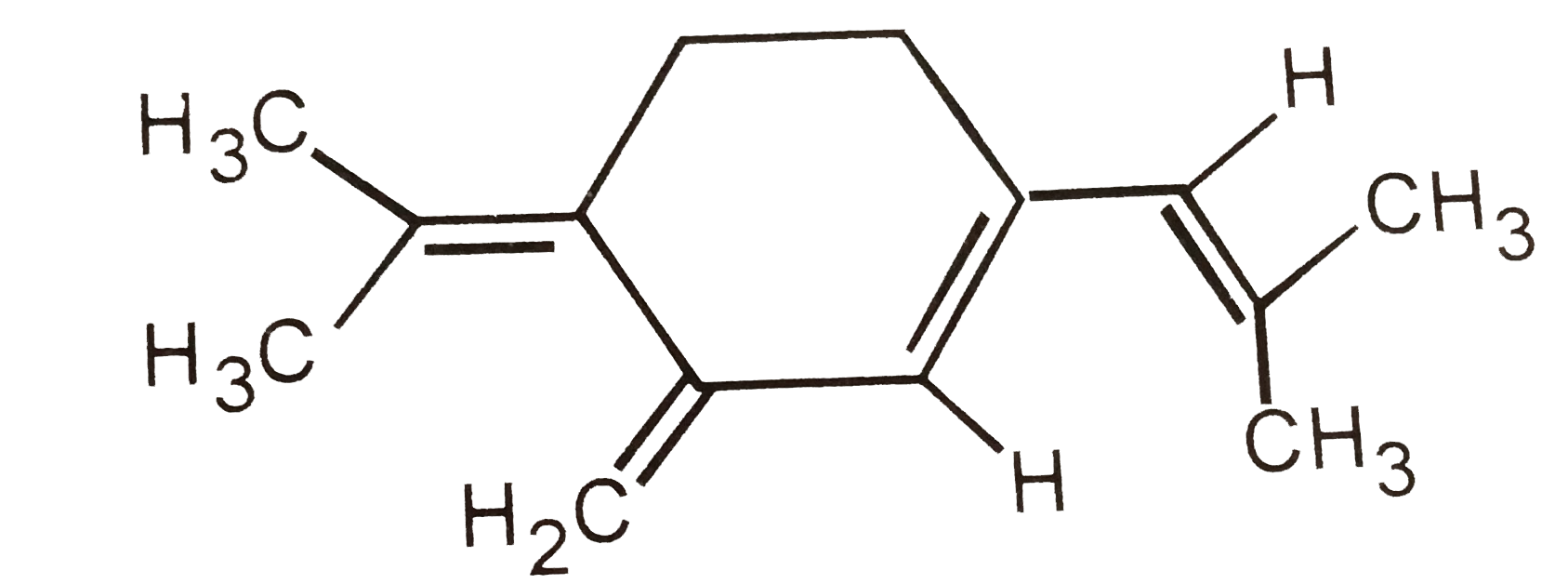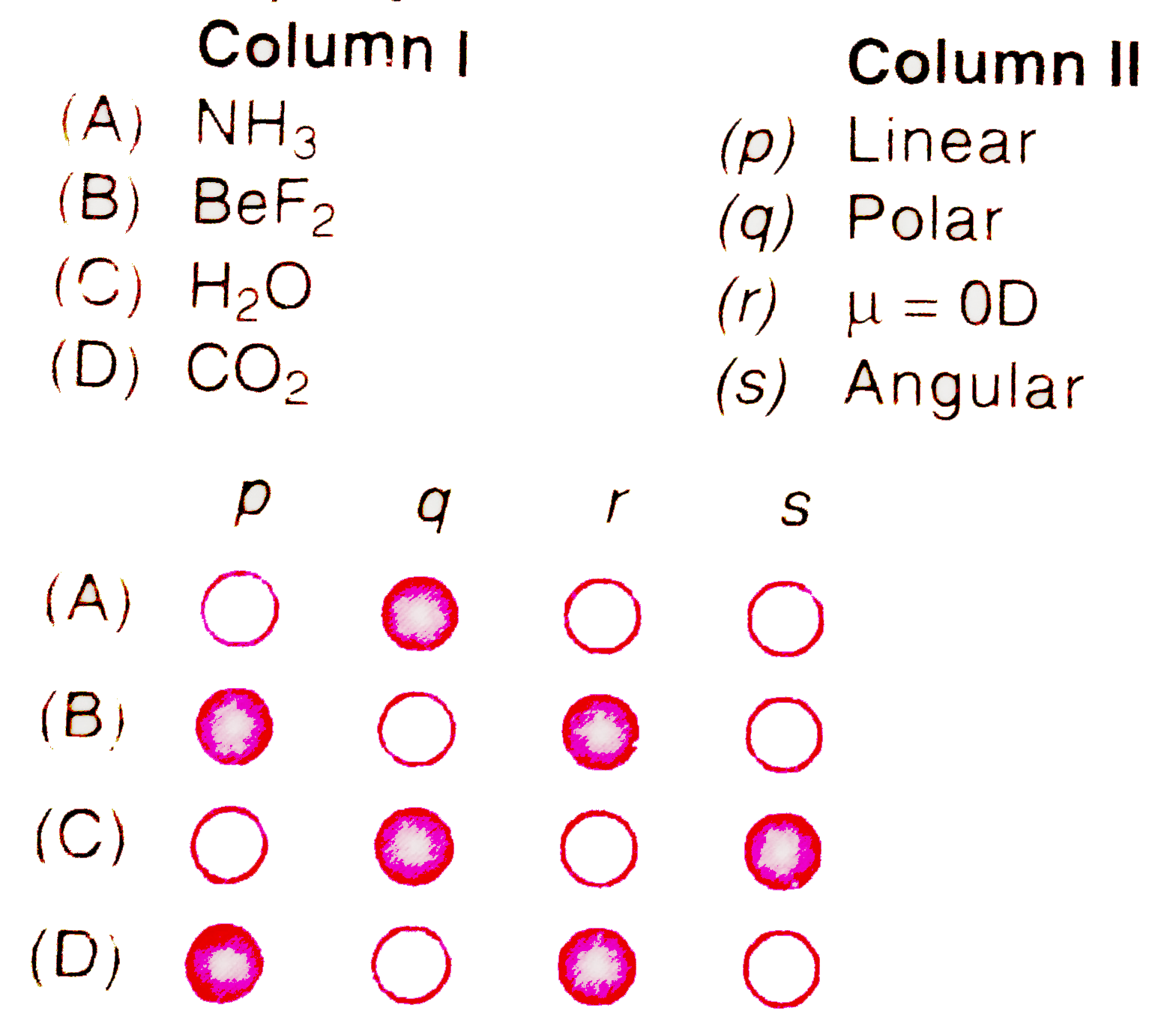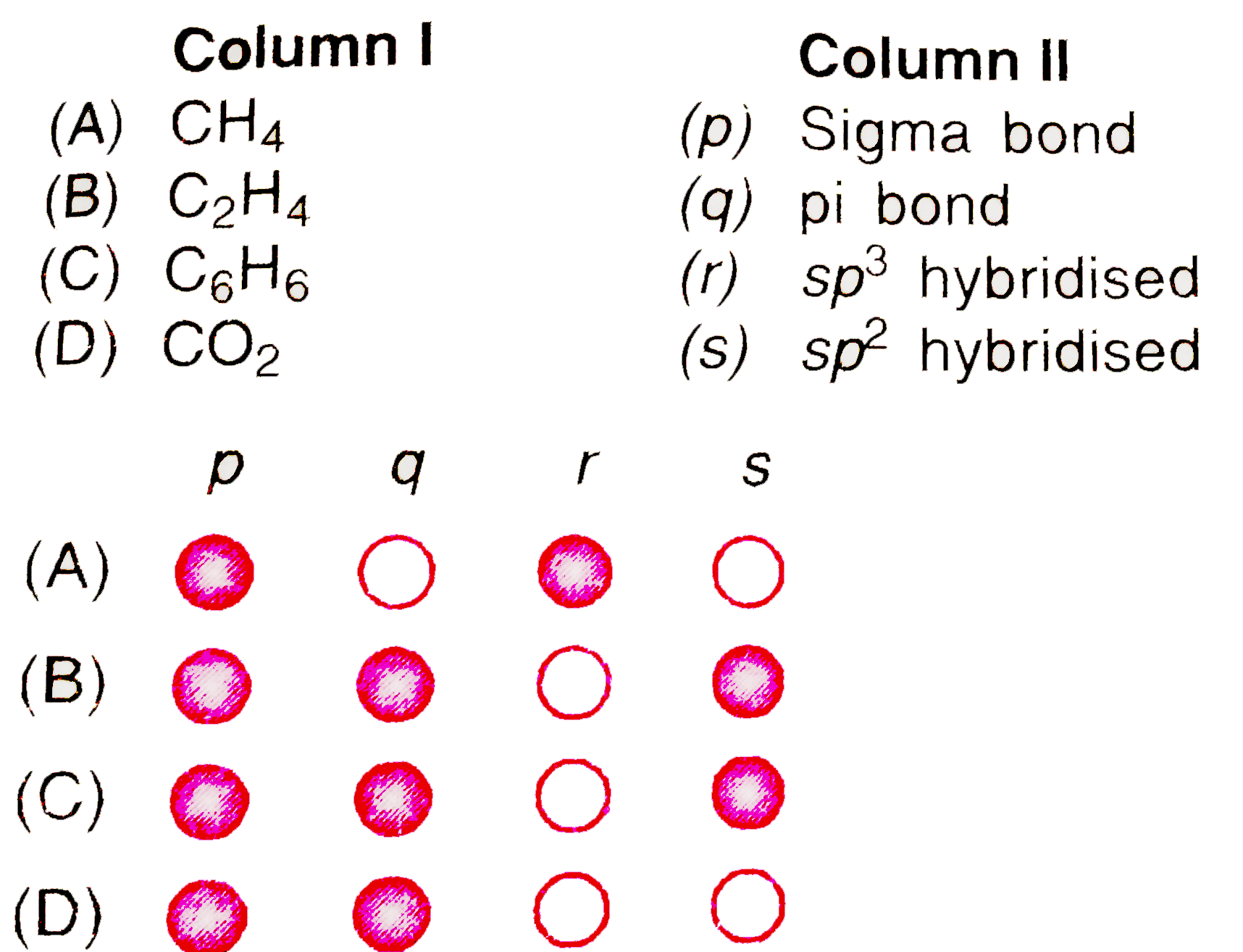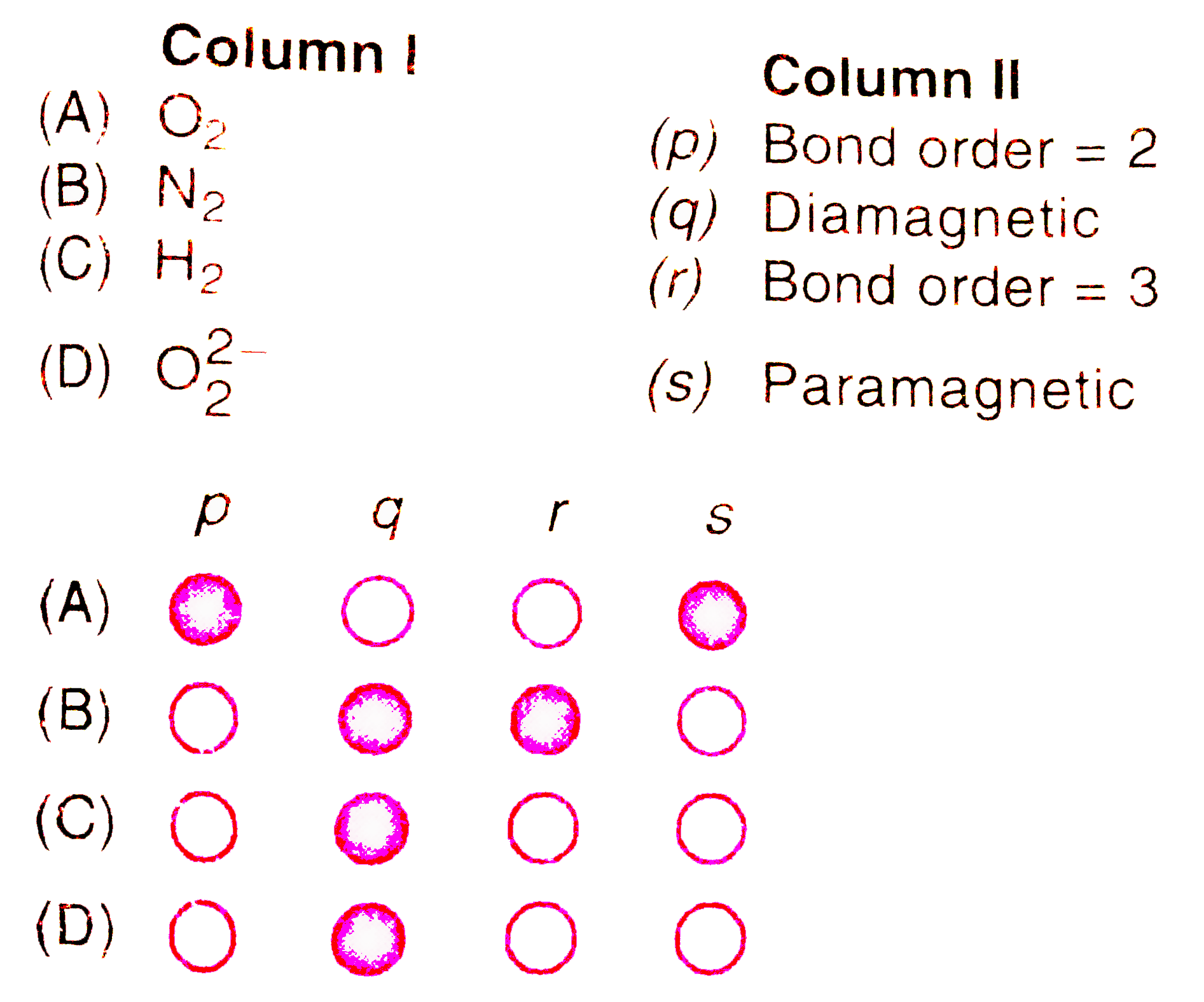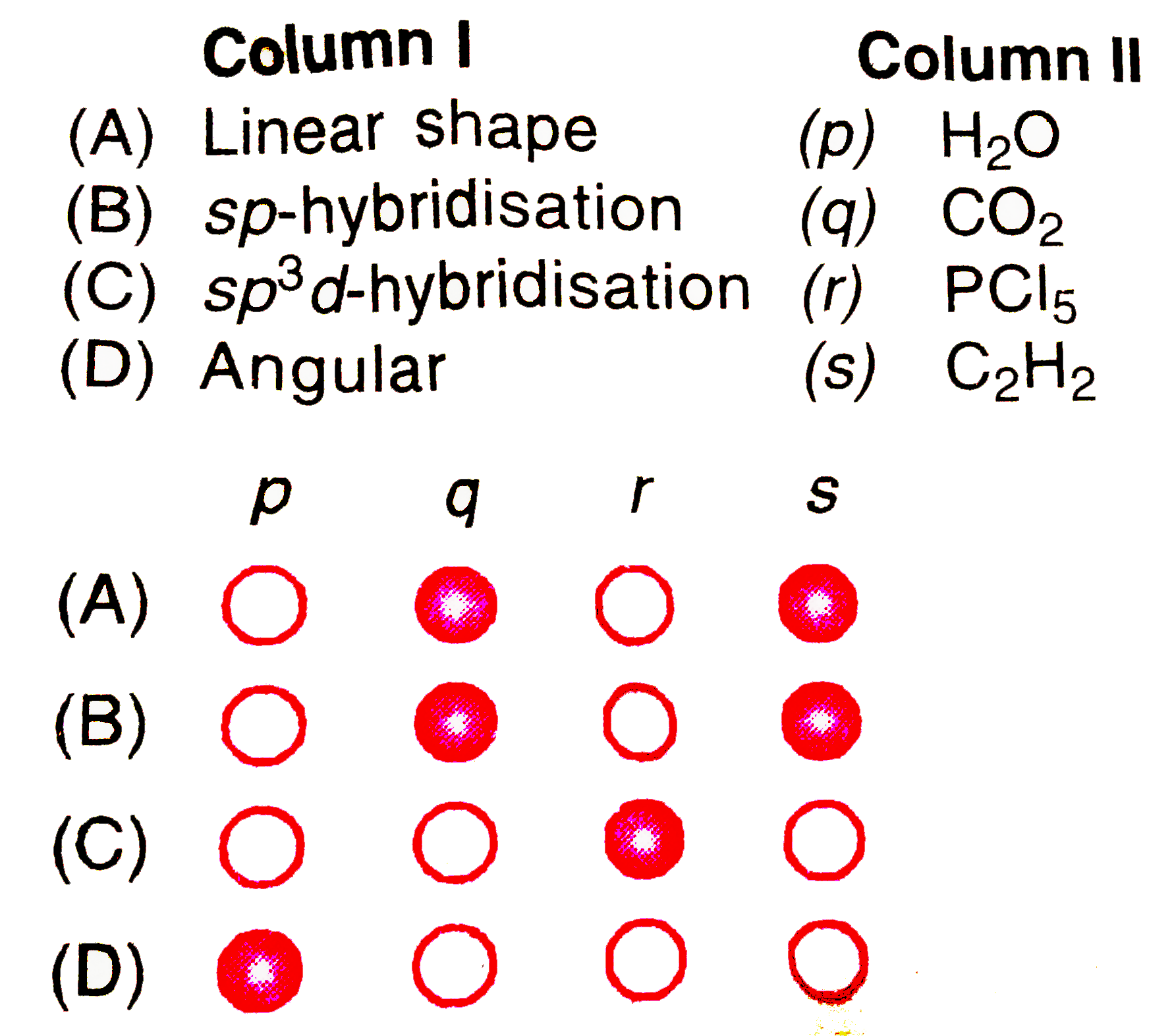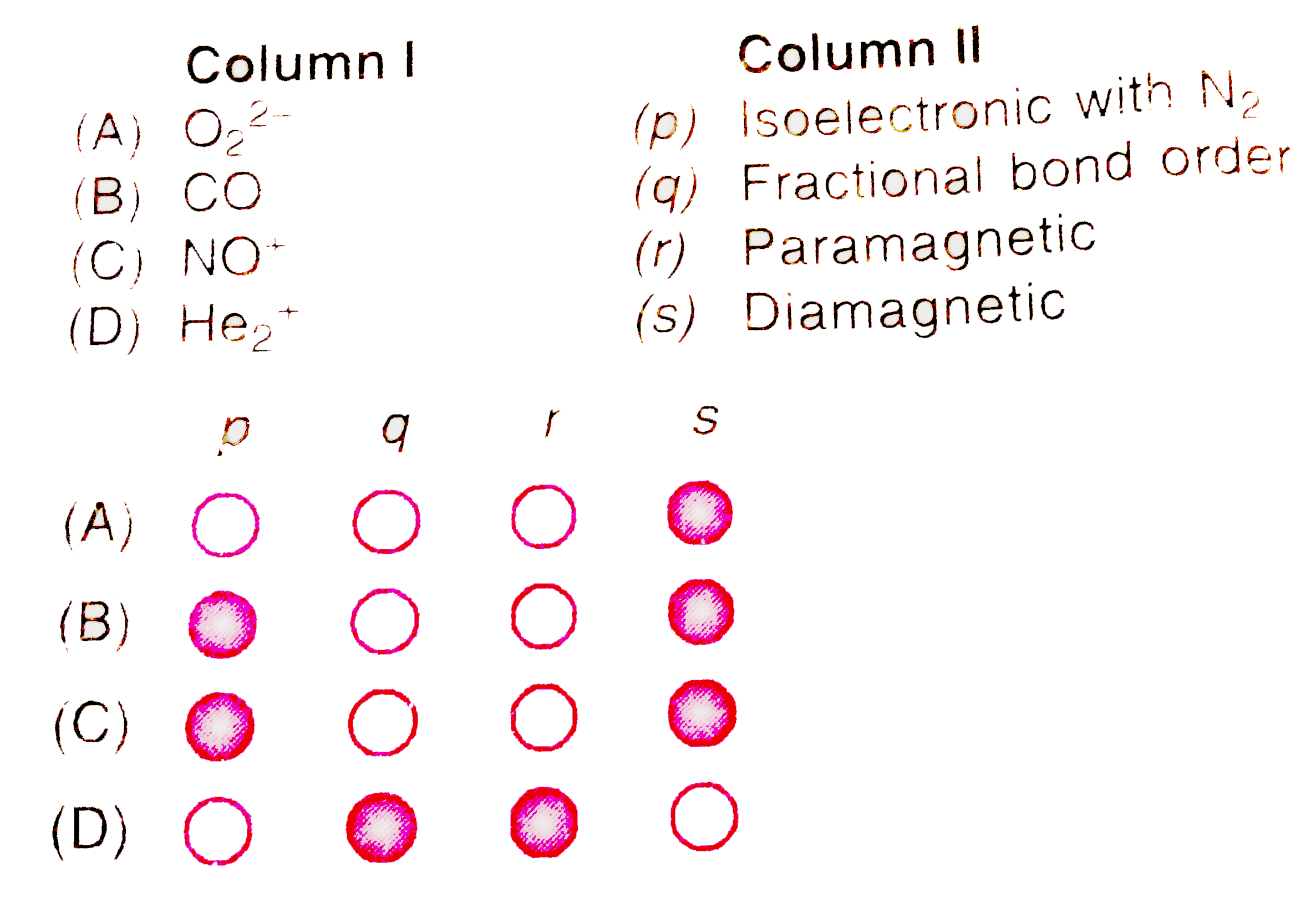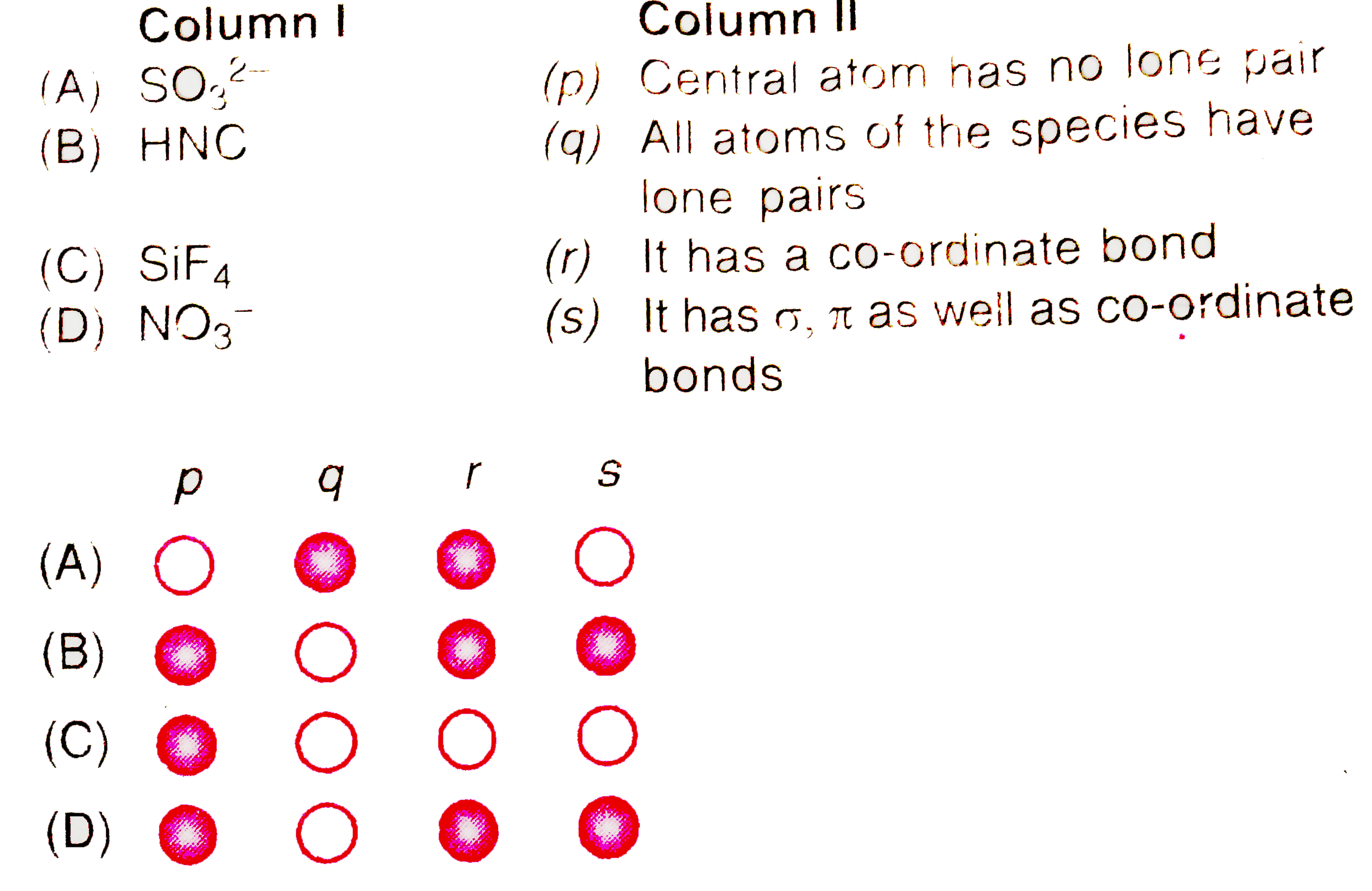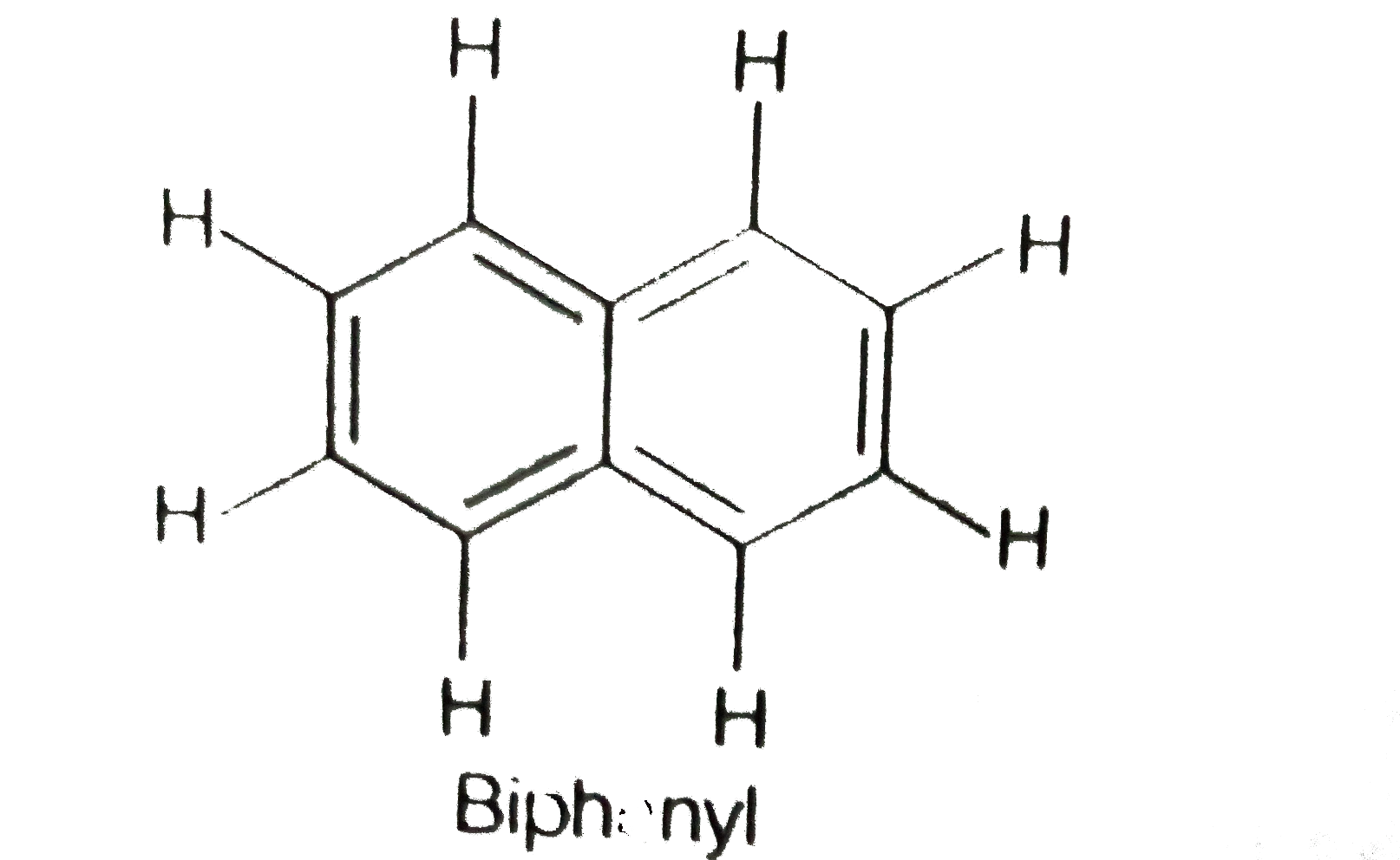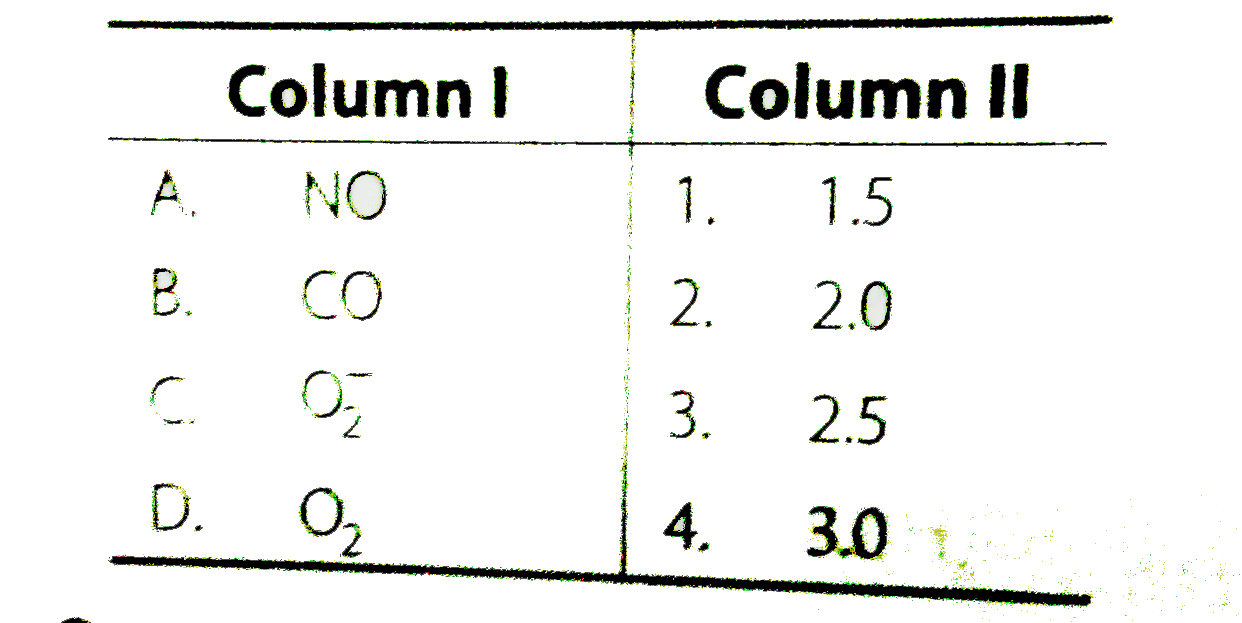STRAIGHT OBJECTIVE TYPE MCQs (SINGLE CORRECT OPTION) from S DINESH & CO CHEMISTRY (HINGLISH) CHEMICAL BONDING AND MOLECULAR STRUCTURE for Class 11
| Class 11 | CHEMISTRY |
| Chapter | CHEMICAL BONDING AND MOLECULAR STRUCTURE |
| S DINESH & CO CHEMISTRY (HINGLISH) | STRAIGHT OBJECTIVE TYPE MCQs (SINGLE CORRECT OPTION) |
| Medium | English |
| Academic Year | 2023-2024 |
Question 258
L.C.A.O. Principle is involved in the formationof the molecular orbitals according ot molecular orbital theory. The energy of the bonding molecular orbital is less than that of thecombining atomic orbitals while that of the antibonding molecular orbitals while that of the order (B.O.)=12(Nb−Na) helps in predicting (i) formation of molecules/molecular ions, bond dossociation energy, stability and bond length. Only the molecules or ions with positive B.O. can be formed. These will be diamagnetic if all molecular orbitals are dilled and paramagnetic if one of more are half filled. The atomic prbitals at the time of overlap must have the same symmetry as well.
Which of the followijng combinatinos is not allowed (assume z axis as the internuclear azis) ?View SolutionQuestion 259
L.C.A.O. Principle is involved in the formationof the molecular orbitals according ot molecular orbital theory. The energy of the bonding molecular orbital is less than that of thecombining atomic orbitals while that of the antibonding molecular orbitals while that of the order (B.O.)=12(Nb−Na) helps in predicting (i) formation of molecules/molecular ions, bond dossociation energy, stability and bond length. Only the molecules or ions with positive B.O. can be formed. These will be diamagnetic if all molecular orbitals are dilled and paramagnetic if one of more are half filled. The atomic prbitals at the time of overlap must have the same symmetry as well.
Bond arder is :View SolutionQuestion 260
L.C.A.O. Principle is involved in the formationof the molecular orbitals according ot molecular orbital theory. The energy of the bonding molecular orbital is less than that of thecombining atomic orbitals while that of the antibonding molecular orbitals while that of the order (B.O.)=12(Nb−Na) helps in predicting (i) formation of molecules/molecular ions, bond dossociation energy, stability and bond length. Only the molecules or ions with positive B.O. can be formed. These will be diamagnetic if all molecular orbitals are dilled and paramagnetic if one of more are half filled. The atomic prbitals at the time of overlap must have the same symmetry as well.
In the formation of N+2 from N2, the electron is removed from a View SolutionQuestion 261
L.C.A.O. Principle is involved in the formationof the molecular orbitals according ot molecular orbital theory. The energy of the bonding molecular orbital is less than that of thecombining atomic orbitals while that of the antibonding molecular orbitals while that of the order (B.O.)=12(Nb−Na) helps in predicting (i) formation of molecules/molecular ions, bond dossociation energy, stability and bond length. Only the molecules or ions with positive B.O. can be formed. These will be diamagnetic if all molecular orbitals are dilled and paramagnetic if one of more are half filled. The atomic prbitals at the time of overlap must have the same symmetry as well.
The bond order (B.O.) in B2 molecule is:View SolutionQuestion 262
L.C.A.O. Principle is involved in the formationof the molecular orbitals according ot molecular orbital theory. The energy of the bonding molecular orbital is less than that of thecombining atomic orbitals while that of the antibonding molecular orbitals while that of the order (B.O.)=12(Nb−Na) helps in predicting (i) formation of molecules/molecular ions, bond dossociation energy, stability and bond length. Only the molecules or ions with positive B.O. can be formed. These will be diamagnetic if all molecular orbitals are dilled and paramagnetic if one of more are half filled. The atomic prbitals at the time of overlap must have the same symmetry as well.
In the homonuclear molecule3 which of the following sets of M.O. orbitals are degenerate ?View SolutionQuestion 263
The concept of hybridisation has been introduced to explain the shapes of molecules. It involves the intermixing of two or more atomic orbitals belonging to same atom but in or more atomic orbitals beloging to sasme atom but in different sub-shells so as to intermix and redistibute energies to from equivalent orbitals called hybrid orbitals.Depending upon toh enumber and nature of the orbitals involved, the hybridisation may be divided into sp (linear), sp2 (trigonal), sp3 (tetrahedral), sp3d (trigonal bipyramidal), sp3d3 (octahedral) and sp3d3 (pentagonal bipyramidal) types. it may be noted that the orbitals of isolated atoms never hybridise and they do so at the time of bond formation.
A hybrid orbital from s-and p-orbitals can contribute to View SolutionQuestion 264
The concept of hybridisation has been introduced to explain the shapes of molecules. It involves the intermixing of two or more atomic orbitals belonging to same atom but in or more atomic orbitals beloging to sasme atom but in different sub-shells so as to intermix and redistibute energies to from equivalent orbitals called hybrid orbitals.Depending upon toh enumber and nature of the orbitals involved, the hybridisation may be divided into sp (linear), sp2 (trigonal), sp3 (tetrahedral), sp3d (trigonal bipyramidal), sp3d3 (octahedral) and sp3d3 (pentagonal bipyramidal) types. it may be noted that the orbitals of isolated atoms never hybridise and they do so at the time of bond formation.
Which carbon is maximum electronegative ?View SolutionQuestion 265
The concept of hybridisation has been introduced to explain the shapes of molecules. It involves the intermixing of two or more atomic orbitals belonging to same atom but in or more atomic orbitals beloging to sasme atom but in different sub-shells so as to intermix and redistibute energies to from equivalent orbitals called hybrid orbitals.Depending upon toh enumber and nature of the orbitals involved, the hybridisation may be divided into sp (linear), sp2 (trigonal), sp3 (tetrahedral), sp3d (trigonal bipyramidal), sp3d3 (octahedral) and sp3d3 (pentagonal bipyramidal) types. it may be noted that the orbitals of isolated atoms never hybridise and they do so at the time of bond formation.
The hybrid state of carbon in C2H2 is same as that of carbon in:View SolutionQuestion 266
The concept of hybridisation has been introduced to explain the shapes of molecules. It involves the intermixing of two or more atomic orbitals belonging to same atom but in or more atomic orbitals beloging to sasme atom but in different sub-shells so as to intermix and redistibute energies to from equivalent orbitals called hybrid orbitals.Depending upon toh enumber and nature of the orbitals involved, the hybridisation may be divided into sp (linear), sp2 (trigonal), sp3 (tetrahedral), sp3d (trigonal bipyramidal), sp3d3 (octahedral) and sp3d3 (pentagonal bipyramidal) types. it may be noted that the orbitals of isolated atoms never hybridise and they do so at the time of bond formation.
The hybridisation of phostphorus in PCOl3 is the same as:View SolutionQuestion 267
The concept of hybridisation has been introduced to explain the shapes of molecules. It involves the intermixing of two or more atomic orbitals belonging to same atom but in or more atomic orbitals beloging to sasme atom but in different sub-shells so as to intermix and redistibute energies to from equivalent orbitals called hybrid orbitals.Depending upon toh enumber and nature of the orbitals involved, the hybridisation may be divided into sp (linear), sp2 (trigonal), sp3 (tetrahedral), sp3d (trigonal bipyramidal), sp3d3 (octahedral) and sp3d3 (pentagonal bipyramidal) types. it may be noted that the orbitals of isolated atoms never hybridise and they do so at the time of bond formation.
The d-orbital involved in dsp2 hybridisation is:View SolutionQuestion 268
Whenever, anion and cation approach each other, the valence shell of the anion is pulled towards the uncleus of the anion is pulled towards the nucles of the cation and as a result, the shape of the anion gets cation is known as polarization of polarizing an amion by a cation is known as polarrization. The ability or capacity of a cation of polarizethe anion towards litsef, is known as its polarizing power. Similiarty. the ability or capacity of an anion to get polarized by the cation, is known as its polarizability. As a result of polarisation, the two ions tend to come closer and the ionic character of the ionic ond acquired partial covalent character. The magnitude of polarization depends upon a number of factors whihc were suggested by Fazan and are termed as Fazan rules.
which of the halides, there is maximum polarization ?View SolutionQuestion 269
Whenever, anion and cation approach each other, the valence shell of the anion is pulled towards the uncleus of the anion is pulled towards the nucles of the cation and as a result, the shape of the anion gets cation is known as polarization of polarizing an amion by a cation is known as polarrization. The ability or capacity of a cation of polarizethe anion towards litsef, is known as its polarizing power. Similiarty. the ability or capacity of an anion to get polarized by the cation, is known as its polarizability. As a result of polarisation, the two ions tend to come closer and the ionic character of the ionic ond acquired partial covalent character. The magnitude of polarization depends upon a number of factors whihc were suggested by Fazan and are termed as Fazan rules.
Which is most covalent in nature ?View SolutionQuestion 270
Whenever, anion and cation approach each other, the valence shell of the anion is pulled towards the uncleus of the anion is pulled towards the nucles of the cation and as a result, the shape of the anion gets cation is known as polarization of polarizing an amion by a cation is known as polarrization. The ability or capacity of a cation of polarizethe anion towards litsef, is known as its polarizing power. Similiarty. the ability or capacity of an anion to get polarized by the cation, is known as its polarizability. As a result of polarisation, the two ions tend to come closer and the ionic character of the ionic ond acquired partial covalent character. The magnitude of polarization depends upon a number of factors whihc were suggested by Fazan and are termed as Fazan rules.
Non-aqueous solvent like eather is added to the mixture of LiCl, NaCl. Which will be extracted by ether ?View SolutionQuestion 271
Whenever, anion and cation approach each other, the valence shell of the anion is pulled towards the uncleus of the anion is pulled towards the nucles of the cation and as a result, the shape of the anion gets cation is known as polarization of polarizing an amion by a cation is known as polarrization. The ability or capacity of a cation of polarizethe anion towards litsef, is known as its polarizing power. Similiarty. the ability or capacity of an anion to get polarized by the cation, is known as its polarizability. As a result of polarisation, the two ions tend to come closer and the ionic character of the ionic ond acquired partial covalent character. The magnitude of polarization depends upon a number of factors whihc were suggested by Fazan and are termed as Fazan rules.
Which has the minimum melting point ? View SolutionQuestion 339
Which of the following options represents the correct bond order?
Thinking process
To calcualte bond order, write the molecular orbital configuration of particular species and afterwards using the formula.
Bond order =12 [Number of bonding (N6) - Number of anti-bonding electrons (Na)]View SolutionQuestion 358
Molecular orbitals are formed by the overlap of atomic orbitals. Two atomic orbitals combine atom from two molecular orbitals called vonding molecular orbital (BOM) and anti bonding molecular orbital (ABMO). Energy of anti bonding orbital is raised above the parent atomic orbitals that have combined and the energy of the bonding orbital is lowered than the parent atomic orbitals. Energies of various molecular orbitals for elements hydrogen to nitrogne increase in the order :
σ1s<σ∗1s<σ2s<σ∗2s<(π2py≈π2py)<σ2py<(π∗2py≈π∗2py)<σ∗2pz and for ozygen and fluorine order of energy of molecular orbitals id given below :
σ1s<σ∗1s<σ2s<σ∗2s<σ2pz<(π∗2px≈π∗2py)σ∗2pz
Different atomic orbitals of one atom combine wiht the atomic orbitals of the second atom whihc have comparable energies and proper orientation. Further, if the overlapping is head on, the molecular orbital is called 'Sigma' (σ) and if the overlap is atreal, the molecular orbital is called 'pi', (π). The molecular orbitals are filled with electrons according to the same rules as followed for filling of atomic orbitals. However, the order for filling is not the same for all molecules or their ions, Bond order is one the most ipmrtaint parameters to compare the strength of bonds.
Which of the following statements is correct ?View SolutionQuestion 359
Molecular orbitals are formed by the overlap of atomic orbitals. Two atomic orbitals combine atom from two molecular orbitals called vonding molecular orbital (BOM) and anti bonding molecular orbital (ABMO). Energy of anti bonding orbital is raised above the parent atomic orbitals that have combined and the energy of the bonding orbital is lowered than the parent atomic orbitals. Energies of various molecular orbitals for elements hydrogen to nitrogne increase in the order :
σ1s<σ∗1s<σ2s<σ∗2s<(π2py≈π2py)<σ2py<(π∗2py≈π∗2py)<σ∗2pz and for ozygen and fluorine order of energy of molecular orbitals id given below :
σ1s<σ∗1s<σ2s<σ∗2s<σ2pz<(π∗2px≈π∗2py)σ∗2pz
Different atomic orbitals of one atom combine wiht the atomic orbitals of the second atom whihc have comparable energies and proper orientation. Further, if the overlapping is head on, the molecular orbital is called 'Sigma' (σ) and if the overlap is atreal, the molecular orbital is called 'pi', (π). The molecular orbitals are filled with electrons according to the same rules as followed for filling of atomic orbitals. However, the order for filling is not the same for all molecules or their ions, Bond order is one the most ipmrtaint parameters to compare the strength of bonds.
Which of the following molecular orbital has maximum number of nodal planes ?View SolutionQuestion 360
Molecular orbitals are formed by the overlap of atomic orbitals. Two atomic orbitals combine atom from two molecular orbitals called vonding molecular orbital (BOM) and anti bonding molecular orbital (ABMO). Energy of anti bonding orbital is raised above the parent atomic orbitals that have combined and the energy of the bonding orbital is lowered than the parent atomic orbitals. Energies of various molecular orbitals for elements hydrogen to nitrogne increase in the order :
σ1s<σ∗1s<σ2s<σ∗2s<(π2py≈π2py)<σ2py<(π∗2py≈π∗2py)<σ∗2pz and for ozygen and fluorine order of energy of molecular orbitals id given below :
σ1s<σ∗1s<σ2s<σ∗2s<σ2pz<(π∗2px≈π∗2py)σ∗2pz
Different atomic orbitals of one atom combine wiht the atomic orbitals of the second atom whihc have comparable energies and proper orientation. Further, if the overlapping is head on, the molecular orbital is called 'Sigma' (σ) and if the overlap is atreal, the molecular orbital is called 'pi', (π). The molecular orbitals are filled with electrons according to the same rules as followed for filling of atomic orbitals. However, the order for filling is not the same for all molecules or their ions, Bond order is one the most ipmrtaint parameters to compare the strength of bonds.
Which of the following pair is expected to have the same bond order ?View SolutionQuestion 361
Molecular orbitals are formed by the overlap of atomic orbitals. Two atomic orbitals combine atom from two molecular orbitals called vonding molecular orbital (BOM) and anti bonding molecular orbital (ABMO). Energy of anti bonding orbital is raised above the parent atomic orbitals that have combined and the energy of the bonding orbital is lowered than the parent atomic orbitals. Energies of various molecular orbitals for elements hydrogen to nitrogne increase in the order :
σ1s<σ∗1s<σ2s<σ∗2s<(π2py≈π2py)<σ2py<(π∗2py≈π∗2py)<σ∗2pz and for ozygen and fluorine order of energy of molecular orbitals id given below :
σ1s<σ∗1s<σ2s<σ∗2s<σ2pz<(π∗2px≈π∗2py)σ∗2pz
Different atomic orbitals of one atom combine wiht the atomic orbitals of the second atom whihc have comparable energies and proper orientation. Further, if the overlapping is head on, the molecular orbital is called 'Sigma' (σ) and if the overlap is atreal, the molecular orbital is called 'pi', (π). The molecular orbitals are filled with electrons according to the same rules as followed for filling of atomic orbitals. However, the order for filling is not the same for all molecules or their ions, Bond order is one the most ipmrtaint parameters to compare the strength of bonds.
In which of the following molecules σ2pz molecular orbital is filled after π2pxandπ2py molecular orbitals ?View Solution
All Exercises from S DINESH & CO CHEMISTRY (HINGLISH) Class 11 CHEMISTRY CHEMICAL BONDING AND MOLECULAR STRUCTURE
- COMPREHENSION
- COVALENT AND CO-ORDINATE BONDS
- HYDROGEN BONDING
- III.MATCHING TYPE QUESTIONS
- IONIC BOND
- IV. ASSERTION-REASON TYPE QUESTIONS
- JEE (JOINT ENTRANGE EXAMINATION) ADVANCED COMPREHENSION LINKED MCQS
- JEE (MAIN) & OTHER ENGINEERING ENTRANCE EXAMINATIONS
- MATRIX-MATCH TYPE QUEDTIONS
- MULTIPLE CHOICE ANSWER TYPE MCQS
- MULTIPLE CHOICE QUESTIONS (TYPE -1)
- MULTIPLE CHOICE QUESTIONS (TYPE -II)
- MULTIPLE CHOICE QUESTIONS BANK (MCQB)
- MULTIPLE CHOICE QUESTIONS MCQS
- PROMBEMS FOR PRACTICE
- REASON TYPE QUESTIONS
- STRAIGHT OBJECTIVE TYPE MCQS (SINGLE CORRECT OPTION)
- COMPREHENSION
- COVALENT AND CO-ORDINATE BONDS
- HYDROGEN BONDING
- III.MATCHING TYPE QUESTIONS
- IONIC BOND
- IV. ASSERTION-REASON TYPE QUESTIONS
- JEE (JOINT ENTRANGE EXAMINATION) ADVANCED COMPREHENSION LINKED MCQS
- JEE (MAIN) & OTHER ENGINEERING ENTRANCE EXAMINATIONS
- MATRIX-MATCH TYPE QUEDTIONS
- MULTIPLE CHOICE ANSWER TYPE MCQS
- MULTIPLE CHOICE QUESTIONS (TYPE -1)
- MULTIPLE CHOICE QUESTIONS (TYPE -II)
- MULTIPLE CHOICE QUESTIONS BANK (MCQB)
- MULTIPLE CHOICE QUESTIONS MCQS
- PROMBEMS FOR PRACTICE
- REASON TYPE QUESTIONS
- STRAIGHT OBJECTIVE TYPE MCQS (SINGLE CORRECT OPTION)
- QUESTION BANK
- COMPREHENSION
- COVALENT AND CO-ORDINATE BONDS
- HYDROGEN BONDING
- III.MATCHING TYPE QUESTIONS
- IONIC BOND
- IV. ASSERTION-REASON TYPE QUESTIONS
- JEE (JOINT ENTRANGE EXAMINATION) ADVANCED COMPREHENSION LINKED MCQS
- JEE (MAIN) & OTHER ENGINEERING ENTRANCE EXAMINATIONS
- MATRIX-MATCH TYPE QUEDTIONS
- MULTIPLE CHOICE ANSWER TYPE MCQS
- MULTIPLE CHOICE QUESTIONS (TYPE -1)
- MULTIPLE CHOICE QUESTIONS (TYPE -II)
- MULTIPLE CHOICE QUESTIONS BANK (MCQB)
- MULTIPLE CHOICE QUESTIONS MCQS
- PROMBEMS FOR PRACTICE
- REASON TYPE QUESTIONS
- STRAIGHT OBJECTIVE TYPE MCQS (SINGLE CORRECT OPTION)
- COMPREHENSION
- COVALENT AND CO-ORDINATE BONDS
- HYDROGEN BONDING
- III.MATCHING TYPE QUESTIONS
- IONIC BOND
- IV. ASSERTION-REASON TYPE QUESTIONS
- JEE (JOINT ENTRANGE EXAMINATION) ADVANCED COMPREHENSION LINKED MCQS
- JEE (MAIN) & OTHER ENGINEERING ENTRANCE EXAMINATIONS
- MATRIX-MATCH TYPE QUEDTIONS
- MULTIPLE CHOICE ANSWER TYPE MCQS
- MULTIPLE CHOICE QUESTIONS (TYPE -1)
- MULTIPLE CHOICE QUESTIONS (TYPE -II)
- MULTIPLE CHOICE QUESTIONS BANK (MCQB)
- MULTIPLE CHOICE QUESTIONS MCQS
- PROMBEMS FOR PRACTICE
- REASON TYPE QUESTIONS
- STRAIGHT OBJECTIVE TYPE MCQS (SINGLE CORRECT OPTION)
- QUESTION BANK
- ADDITIONAL IMPORTANT QUASTIONS
- BORD EXAMINATIONS
- EXAMPLE
- H.O.T.S. CONCEPTUAL QUESTIONS
- VALUE BASED QUESTIONS
- ADDITIONAL IMPORTANT QUASTIONS
- BORD EXAMINATIONS
- EXAMPLE
- H.O.T.S. CONCEPTUAL QUESTIONS
- VALUE BASED QUESTIONS
- ADDITIONAL IMPORTANT QUASTIONS
- BORD EXAMINATIONS
- EXAMPLE
- H.O.T.S. CONCEPTUAL QUESTIONS
- VALUE BASED QUESTIONS
- ADDITIONAL IMPORTANT QUASTIONS
- BORD EXAMINATIONS
- EXAMPLE
- H.O.T.S. CONCEPTUAL QUESTIONS
- VALUE BASED QUESTIONS
